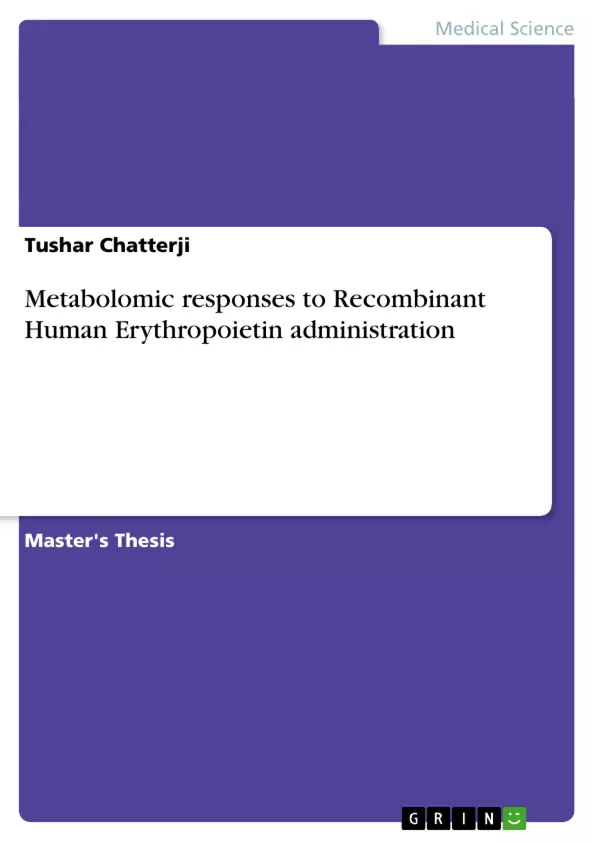Metabolomics is the comprehensive analysis of the metabolite profiles within a biological system. r-HuEPO stimulates red blood cell production, thereby enhancing maximal oxygen delivery to the tissues. The ergogenic potential of r-HuEPO, demonstrated through improved aerobic capacity and performance has reported r-HuEPO to be the most widely abused erythropoietic stimulant till date. This study was aimed at determining the effects of r-HuEPO on the human metabolome by analyzing metabolites from blood plasma and urine. Analysis of these metabolites was then used to determine how such metabolic interactions affected physiological status and exercise performance. Three well trained individuals participated in the study. Blood and urine were collected from the subjects. Plasma and urine samples were analyzed for metabolites by LC-MS Orbitrap and data was analyzed in the form of heatmaps and PCA plots. Further data interpretations for metabolites of interest were performed by a software, mzMatch/PeakML. Analysis of the human metabolome revealed 1000 metabolites which were manually categorized into 190 human metabolites. Significant metabolite patterns in response to r-HuEPO suggested the physiological effects of r-HuEPO on certain metabolites. A better understanding of the metabolic changes mediated by r-HuEPO might provide an insight into the metabolic signals in response to exercise performance.
Inhaltsverzeichnis (Table of Contents)
- Abstract
- Abbreviations
- Introduction
- Genes
Zielsetzung und Themenschwerpunkte (Objectives and Key Themes)
This study aimed to investigate the effects of recombinant human erythropoietin (r-HuEPO) on the human metabolome by analyzing metabolites from blood plasma and urine. The study sought to understand the metabolic interactions affected by r-HuEPO and their impact on physiological status and exercise performance.- Metabolomic analysis of r-HuEPO effects on human blood plasma and urine.
- Impact of r-HuEPO on metabolic pathways and their implications for physiological status.
- Correlation between metabolic changes and exercise performance enhancement.
- Application of LC-MS Orbitrap for metabolite analysis in the context of exercise physiology.
- Contribution of metabolomics to the understanding of r-HuEPO's ergogenic potential.
Zusammenfassung der Kapitel (Chapter Summaries)
- Abstract: This chapter provides a concise overview of the study's objective, methodology, and key findings. It highlights the potential of metabolomics in understanding the effects of r-HuEPO on the human body.
- Abbreviations: This chapter lists and defines abbreviations used throughout the text, ensuring clarity and consistency.
- Introduction: This chapter introduces the concept of metabolomics and its importance in systems biology. It outlines the role of r-HuEPO in enhancing athletic performance and discusses the study's rationale for investigating its metabolic effects.
- Genes: This chapter delves into the ‘OMICS’ cascade, highlighting the relationship between genes, mRNA, proteins, and metabolites. It emphasizes the role of metabolomics in providing insights into the phenotype and its response to various factors.
Schlüsselwörter (Keywords)
This research focuses on the analysis of metabolic changes induced by recombinant human erythropoietin (r-HuEPO) administration. Key terms include metabolomics, LC-MS Orbitrap, blood plasma, urine, metabolite profiles, exercise performance, and erythropoiesis. The study explores the implications of r-HuEPO on physiological status and its ergogenic potential in athletes.- Quote paper
- Tushar Chatterji (Author), 2011, Metabolomic responses to Recombinant Human Erythropoietin administration, Munich, GRIN Verlag, https://www.grin.com/document/189541



